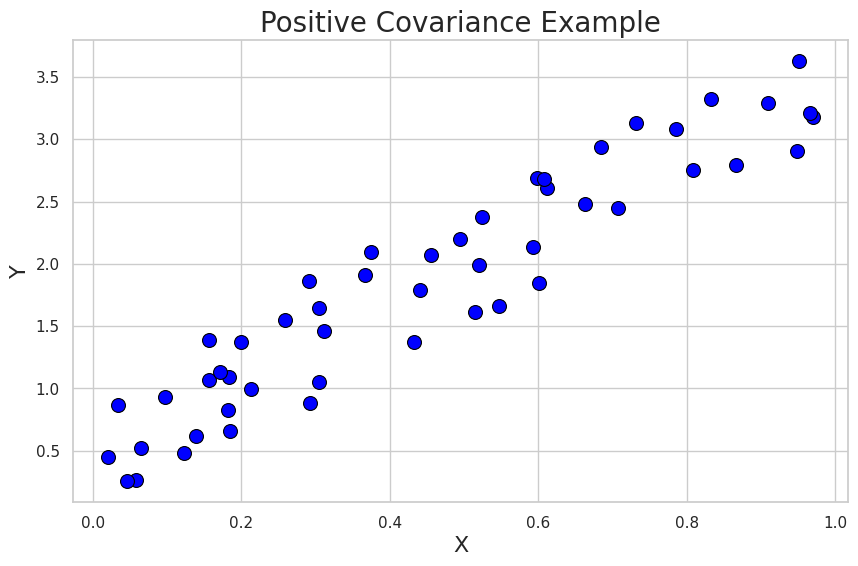共分散とは
共分散とは、2つの変数XとYの関係を表す数値です。一方の変数が増加すると、もう一方の変数が増加または減少するかどうかを示します。
共分散が正である場合、両変数が共に増加または減少する傾向があることを示します。共分散が負である場合、一方の変数が増加すると、他方の変数が減少する傾向があることを示し、その逆も同様です。共分散がゼロの場合、変数間に線形関係がないことを意味します。
変数
ここで、
cov(X,Y) X_i Y_i \overline{X} \overline{Y} n
共分散と相関の違い
共分散は2つの変数の関係の向きを測定するのに対し、相関はその関係の強さと向きを定量化します。相関は、-1から1までの範囲で標準化された共分散であり、共分散は任意の値を取ることができます。
相関係数は、次のように計算されます。
ここで、
r cov(X,Y) \sigma_X \sigma_Y
Pythonで共分散を計算
この章では、Pythonを使用して共分散を計算する方法を説明し、正の共分散と負の共分散の両方の場合を示します。また、変数間の関係を視覚化するためのプロットも作成します。
まずは必要なライブラリをインポートします。
python
import numpy as np
import pandas as pd
import matplotlib.pyplot as plt
import seaborn as sns
次に、2つの変数の間の共分散を計算する関数を作成します。
python
def covariance(x, y):
x_mean = np.mean(x)
y_mean = np.mean(y)
n = len(x)
cov = np.sum((x - x_mean) * (y - y_mean)) / (n - 1)
return cov
正の共分散の例を作成してみます。
python
# Generate sample data with positive covariance
np.random.seed(42)
x_positive = np.random.rand(50)
y_positive = x_positive * 3 + np.random.rand(50)
# Calculate the covariance
positive_cov = covariance(x_positive, y_positive)
print(f"Positive Covariance: {positive_cov}")
# Plot the data
plt.figure(figsize=(10, 6))
sns.set(style="whitegrid")
sns.scatterplot(x=x_positive, y=y_positive, s=100, color="blue", edgecolor="black")
plt.title("Positive Covariance Example", fontsize=20)
plt.xlabel("X", fontsize=16)
plt.ylabel("Y", fontsize=16)
plt.show()
Positive Covariance: 0.25587483932859534

この例では、Xの値が増加すると、Yの値も増加する傾向があることがわかります。プロットは、変数間の正の共分散を示しています。
次に、負の共分散の例を作成してみます。
python
# Generate sample data with negative covariance
np.random.seed(42)
x_negative = np.random.rand(50)
y_negative = -x_negative * 3 + np.random.rand(50)
# Calculate the covariance
negative_cov = covariance(x_negative, y_negative)
print(f"Negative Covariance: {negative_cov}")
# Plot the data
plt.figure(figsize=(10, 6))
sns.set(style="whitegrid")
sns.scatterplot(x=x_negative, y=y_negative, s=100, color="red", edgecolor="black")
plt.title("Negative Covariance Example", fontsize=20)
plt.xlabel("X", fontsize=16)
plt.ylabel("Y", fontsize=16)
plt.show()
Negative Covariance: -0.2448461835209279

この例では、Xの値が増加すると、Yの値が減少する傾向があることがわかります。プロットは、変数間の負の共分散を示しています。
AlloyDB
Amazon Cognito
Amazon EC2
Amazon ECS
Amazon QuickSight
Amazon RDS
Amazon Redshift
Amazon S3
API
Autonomous Vehicle
AWS
AWS API Gateway
AWS Chalice
AWS Control Tower
AWS IAM
AWS Lambda
AWS VPC
BERT
BigQuery
Causal Inference
ChatGPT
Chrome Extension
CircleCI
Classification
Cloud Functions
Cloud IAM
Cloud Run
Cloud Storage
Clustering
CSS
Data Engineering
Data Modeling
Database
dbt
Decision Tree
Deep Learning
Descriptive Statistics
Differential Equation
Dimensionality Reduction
Discrete Choice Model
Docker
Economics
FastAPI
Firebase
GIS
git
GitHub
GitHub Actions
Google
Google Cloud
Google Search Console
Hugging Face
Hypothesis Testing
Inferential Statistics
Interval Estimation
JavaScript
Jinja
Kedro
Kubernetes
LightGBM
Linux
LLM
Mac
Machine Learning
Macroeconomics
Marketing
Mathematical Model
Meltano
MLflow
MLOps
MySQL
NextJS
NLP
Nodejs
NoSQL
ONNX
OpenAI
Optimization Problem
Optuna
Pandas
Pinecone
PostGIS
PostgreSQL
Probability Distribution
Product
Project
Psychology
Python
PyTorch
QGIS
R
ReactJS
Regression
Rideshare
SEO
Singer
sklearn
Slack
Snowflake
Software Development
SQL
Statistical Model
Statistics
Streamlit
Tabular
Tailwind CSS
TensorFlow
Terraform
Transportation
TypeScript
Urban Planning
Vector Database
Vertex AI
VSCode
XGBoost